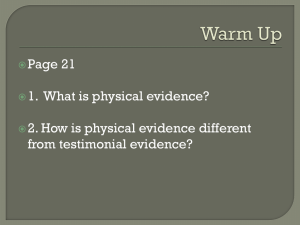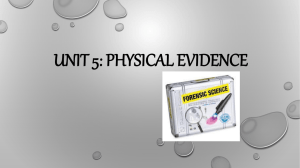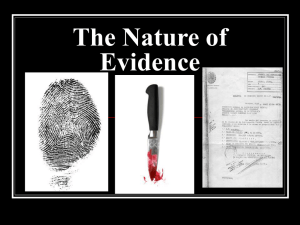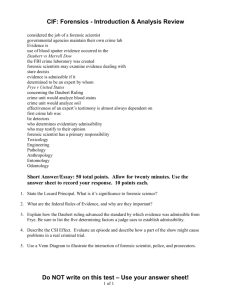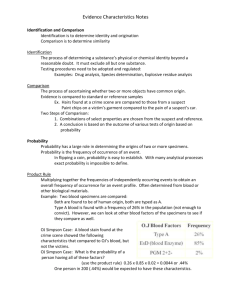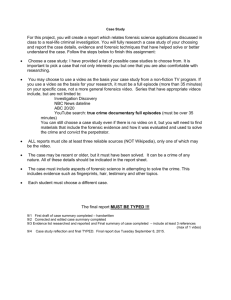9/15 Introduction to Evidence Notes
advertisement
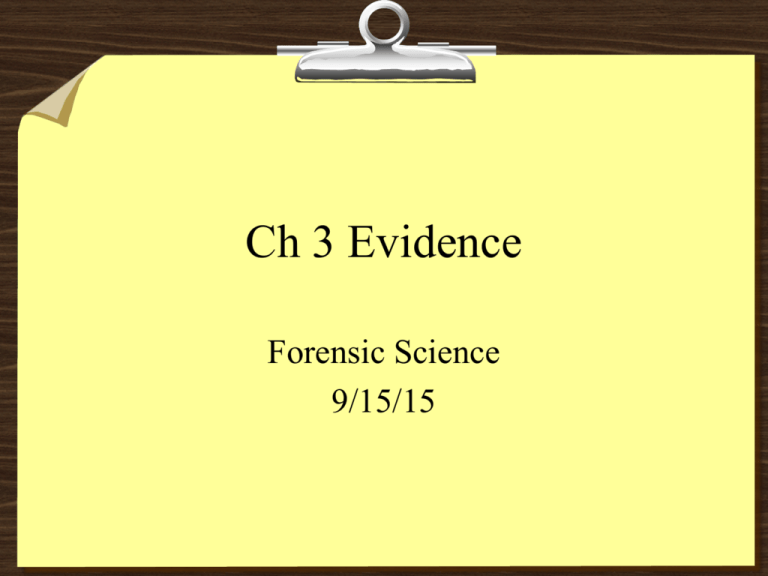
Ch 3 Evidence Forensic Science 9/15/15 Drill • New seats! • Pick up notes packet – four sheets • Take out a sheet of notebook paper. • Number it #1-5 Drill – Homework Review 1. Was the killer in the Green River killings: A.Gary Ridgway B.Thomas Hardy C.Kyle Carter D.Hannibal Lecter Drill – Homework Review 2. Most of the victims of the Green River killer were: A. B. C. D. College students Children Prostitutes Dancers Drill – Homework Review 3. True or False? The perpetrator of the crimes passed a lie detector test about the crimes. Drill – Homework Review 4. The DNA evidence that tied the accused to the crime was from comparing: A. B. C. D. skin and blood blood and hair hair and saliva saliva and semen Drill – Homework Review 5. Minute amounts of were found on the clothing of the victims and in the murderer’s workplace. A. B. C. D. ash paint resin pollen Now, to grade! • • • • Trade with someone near you. Grade out of 5 points. We’re hoping for 4/5 or better! Write “Graded by (your name)” on the paper. Answers • • • • • 1. A 2. C 3. True 4. D 5. B Objectives • SWBAT • Name many forms of physical evidence. • Classify evidence as indirect (circumstantial) or direct. • Classify evidence as individual or class. Types of Evidence Types of Evidence • Evidence can be divided into two types of evidence • Direct evidence – evidence in the form of a statement made under oath, such as a witness pointing to a person in a court saying “that’s the guy who robbed the grocery store.” • Also known as testimonial evidence. Types of Evidence • Evidence can be divided into two types of evidence • Physical evidence – any object or material that is relevant in a crime (also called trace evidence) • Almost any tangible thing, as large as a plane, as small as hair, as fleeting as an odor, or as obvious as a demolished building. Locard’s principle • Edmond Locard, a French Forensic Scientitst: • Always an exchange or transfer of material when two objects came into contact. Types of Common Physical Evidence • • • • • • • • • • • • Drugs and toxic substances Paints Gunshot residues Firearms and ammunition Impressions (shoes, teeth) Petroleum products Alcohols (especially ethanol) Rubber material Resins, plastics Explosive residues Serial numbers documents • • • • • • • • • • • fibers, Soil, glass Blood body fluids Fingerprints Hair Tissues Pollen Wood material Feathers bones Types of Evidence • Most evidence does not prove a fact and is termed indirect or circumstantial evidence. • Some physical evidence, however, may be considered proof of fact, such as possessing a controlled substance or a driver’s blood alcohol level of greater than 0.08%. Types of Evidence • Circumstantial evidence – implies a fact or event. The greater volume of circumstantial evidence there is, the greater the weight it carries. Probability and statistics come into play here. Types of Evidence Explain why this would be or would not be trace evidence Forensic Science: Fundamentals & Investigations, Chapter 18 2 So, What Good is Evidence? • Physical evidence can • Prove that a crime has been committed • Corroborate testimony • Link a suspect with a victim or with a crime scene • Establish the identity of persons associated with a crime • Allow reconstruction of events of a crime Rules of Evidence • Define what evidence is acceptable (admissible) and how it can be used for the jury. • Evidence must be relevant, meaning it must prove something (probative) and address the issue of the particular crime (material). Rules of Evidence • Evidence is admissible if it is reliable and the presenter of such evidence is credible and competent. • Generally, hearsay is inadmissible in criminal court because it is not reliable nor was it taken under oath and therefore does not allow for cross-examination. Hearsay is admissible in civil suits. Two legal decisions • Legal decisions that govern the admissibility of scientific evidence: • Frye versus United States, 1923 • Daubert versus Merrell Dow Pharmaceutical, Inc. Frye Standard • Interpretation of scientific evidence must be given by an expert witness and have gained “general acceptance” in the particular field of study. • The court must decide if the questioned procedure, technique, and principles are generally accepted by a meaningful segment of the relevant scientific community. • Does not offer guidance on reliability. Daubert ruling • Trial judge must assume responsibility and validity of evidence presented in their court. Guidelines: • The scientific theory or technique must be testable. • The theory or technique must be subject to peer review and publication. • Rate of error or potential errors must be stated. • The technique must follow standards. • Consideration must be given as to whether the theory or technique has attracted widespread acceptance within a relevant scientific community. Individual versus Class Evidence • Individual – best evidence, can be to a single specific source, so there is no doubt as to what the source of the evidence is. • Type of evidence can place a suspect at a crime scene, associate a suspect with a victim, and sometimes even prove who committed the crime. • Human characteristics that can be linked to an individual are fingerprints, DNA analysis, handwriting, voice prints. • Individualization always involves comparison. Individual versus Class Evidence • Class evidence is evidence found to be consistent with a particular source. • Class evidence alone may or may not be very convincing in a crime, but if there are many different types or pieces of class evidence, the value can be considerable. • Class evidence is associated with a group or class, like polyester or blue polyester shirts. • Examples of class evidence are hair, fibers, soil, and glass fragments. Individual vs. Class Characteristics • Any item can have both individual and class characteristics. • What do I mean? • ex. Roll of tape, earbuds, pencil • Look at your shoe—make a list of • class characteristics • individual characteristics For example • Pens – who has a… • • • • • • pen ballpoint black ink Bic brand Howard Community College broken pocket clip • Which are class? Which are individual? Individual Characteristics Class Characteristics Purpose of Examining Physical Evidence • The examination of physical evidence by a forensic scientist is usually undertaken for identification or comparison purposes. Identification • The purpose of identification is to determine the physical or chemical identity of a substance with as near absolute certainty as existing analytical techniques will permit. • In other words, WHAT IS IT??? • Red stain: paint or blood? Comparison • In a comparison analysis, a standard/reference sample and the suspect sample are given the same tests and are examined in the same way. • This is to determine if they came from the same place. Example • What are these? (Identification) • Fingerprints • Whose are they? (Comparison) • If you don’t have anything to compare to, you can’t do anything else! Identification • First, test procedures must be developed that give the same results every time, for standard materials. • Next, the same procedures must be used every time to prove the identity of suspect materials. • Finally, there need to be enough tests so that no other material could give the same results. • Example – Ms. Bloedorn’s “-caine” experience Common Types of Identification • The crime laboratory is frequently requested to identify the chemical composition of an illicit drug. • It may be asked to identify gasoline in residues recovered from the debris of a fire, or it may have to identify the nature of explosive residues—for example, dynamite or TNT. • The identification of blood, semen, hair, or wood are also very common and, as a matter of routine, include a determination for species origin. Comparison • A comparative analysis has the important role of determining whether or not a suspect specimen and a standard/reference specimen have a common origin. • Both the standard/reference and the suspect specimen are subject to the same tests. • The forensic comparison is actually a two-step procedure. • First, combinations of select properties are chosen from the suspect and the standard/reference specimen for comparison. • Second, once the examination has been completed, the forensic scientist must be prepared to give a conclusion with respect to the origins. Natural vs. Evidential Limits • There are practical limits to the properties and characteristics the forensic scientist can select for comparison. • Modern analytical techniques have become so sophisticated and sensitive that natural variations in objects become almost infinite. • Example: Electron micrograph of paper No two pieces of paper will be the same at this magnification. What good is class evidence? • The product rule is a formula for determining how frequently a certain combination of characteristics occurs in a population. • Product Rule Example & WS Forensic Databases There are four databases you need to know about. IAFIS • The Integrated Automated Fingerprint Identification System (IAFIS), a national fingerprint and criminal history system maintained by the FBI. CODIS • The Combined DNA Index System (CODIS) enables federal, state, and local crime laboratories to electronically exchange and compare DNA profiles. NIBIN • The National Integrated Ballistics Information Network (NIBIN) allows firearm analysts to acquire, digitize, and compare markings made by a firearm on bullets and cartridge casings. PDQ & SICAR • The International Forensic Automotive Paint Data Query (PDQ) database contains chemical and color information pertaining to original automotive paints. • SICAR (shoeprint image capture and retrieval) is a shoeprint database. Closure • Choose an object. • List the individual and class evidence about that object. • Is there any evidence (fingerprints?) that could be identified? Compared?
